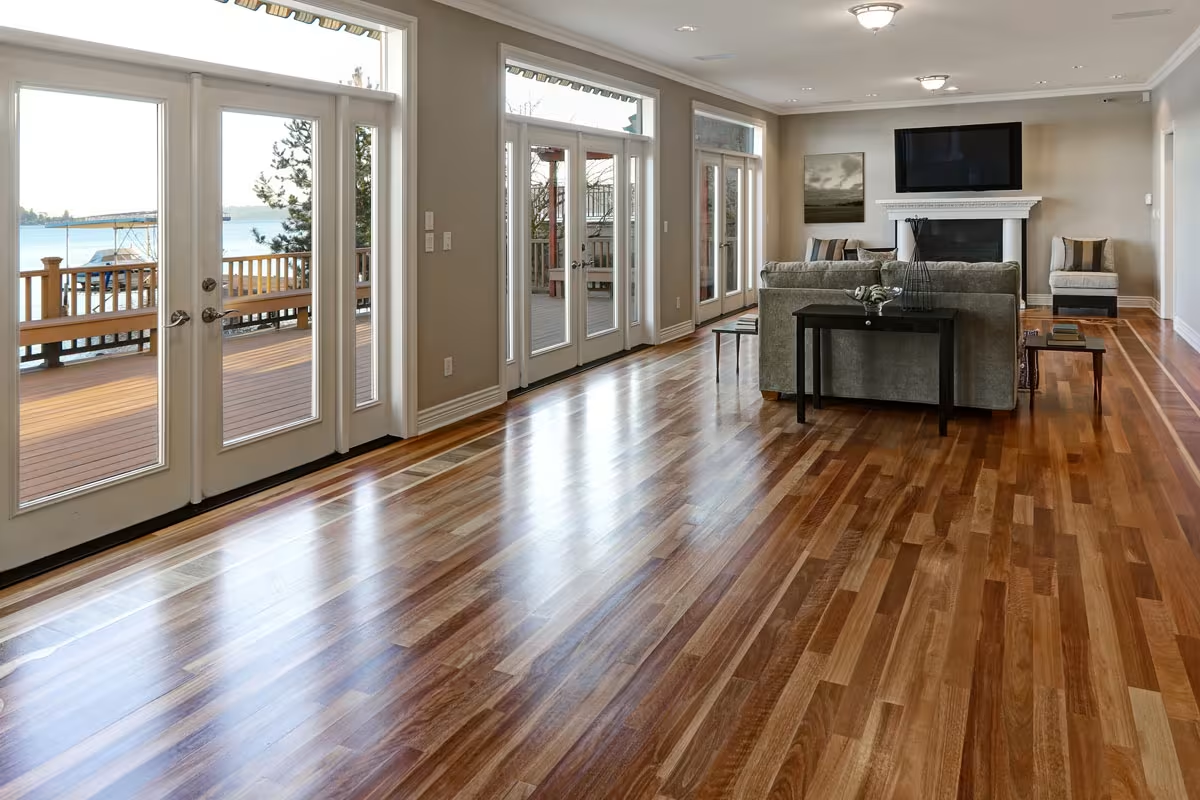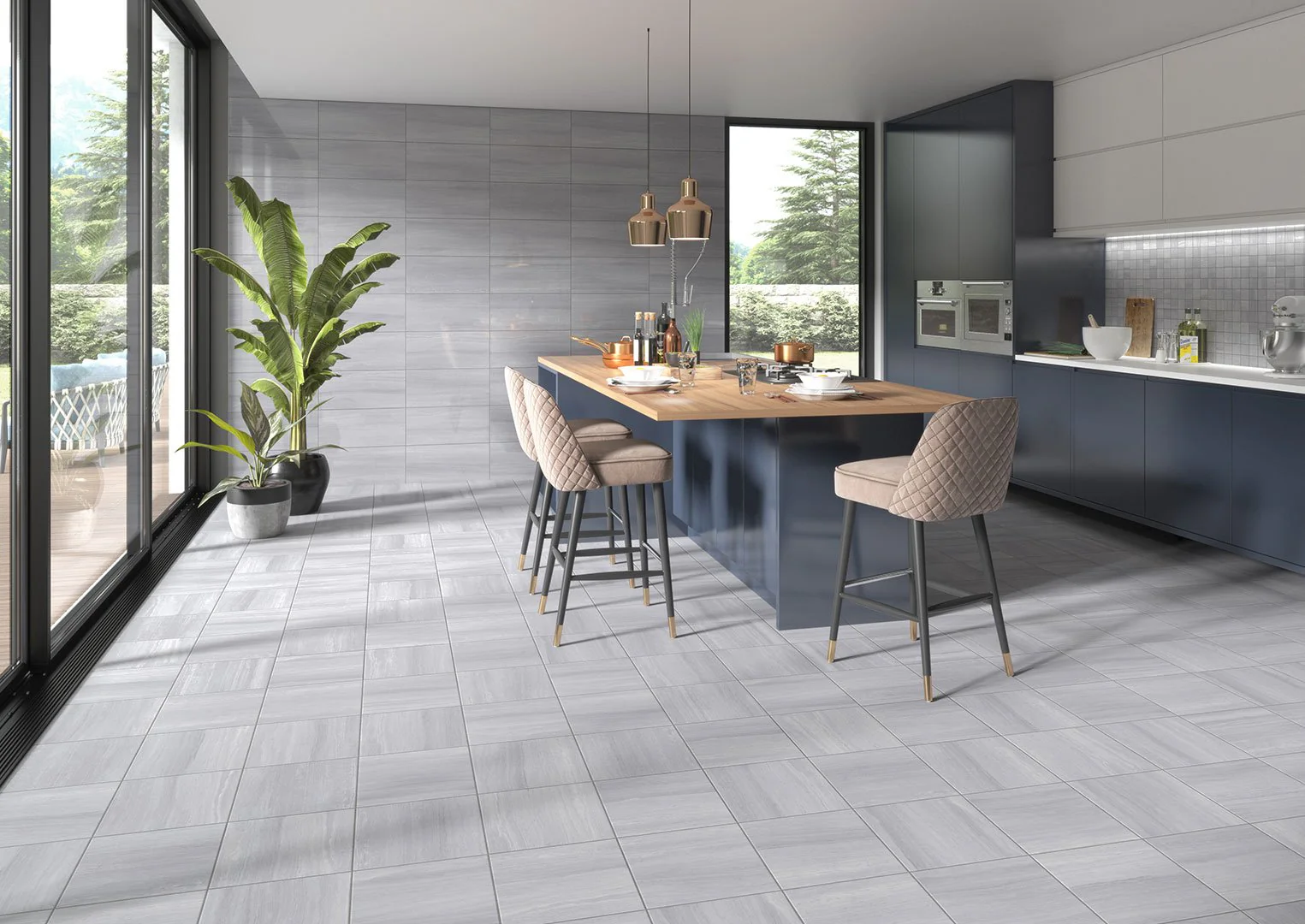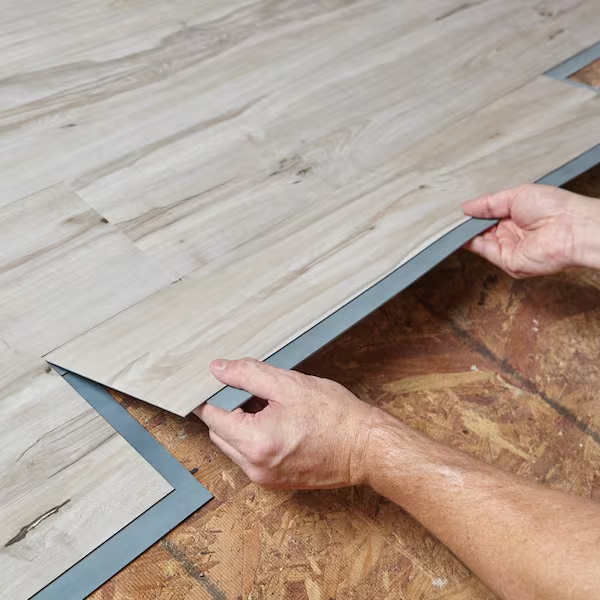
Everything You’ll Need
| Tool/Material | Laminate Flooring | Purpose |
|---|---|---|
| Utility Knife | ✔ | Cut underlayment and trim laminate edges |
| Tape Measure | ✔ | Measure room size and plank cuts |
| Straight Edge | ✔ | Make straight cuts and align |
| Pry Bar | ✔ | Remove baseboards or old floors |
| Spacers | ✔ | Keep expansion gaps by walls |
| Tapping Block | ✔ | Tap planks together gently |
| Non-Marring Hammer | ✔ | Use with tapping block for tight fits |
| Laminate Cutter or Saw | ✔ | Cut planks to size |
| Knee Pads | ✔ | Protect knees while installing |
| Level | ✔ | Ensure subfloor and first row are even |
| Chalk Line | ✔ | Mark straight lines for alignment |
| Underlayment Roll | ✔ (if needed) | Add cushion and soundproofing |
| Jigsaw or Oscillating Tool | ✔ | Cut odd shapes (around pipes, door jambs) |
Step 1: Choose a Layout Pattern
Before you put in your laminate flooring, think about how you want to arrange the planks. Although laminate doesn’t have as many fancy pattern options as other types, your layout choice can still change the room’s look and feel.
Here are some common and effective ways to lay laminate flooring:
Straight Lay Pattern (Most Common)
This is the easiest and most popular option.
Planks are placed parallel to the longest wall or where the light comes in. This gives a clean, classic look that’s great for most rooms.
Diagonal Pattern
For a more stylish look.
Planks are placed at a 45-degree angle to the walls. This can make small rooms seem bigger or add interest to square spaces. Keep in mind, this may need more cutting and materials.
Random/Variable Stagger
Planks are staggered with different lengths.
This looks like natural hardwood and avoids lining up patterns or seams.
Herringbone or Chevron (Advanced/Pro)
Some special laminate floors are made for herringbone or chevron styles.
These look great but need precise cuts and planning. Not all laminate brands have planks for these patterns.
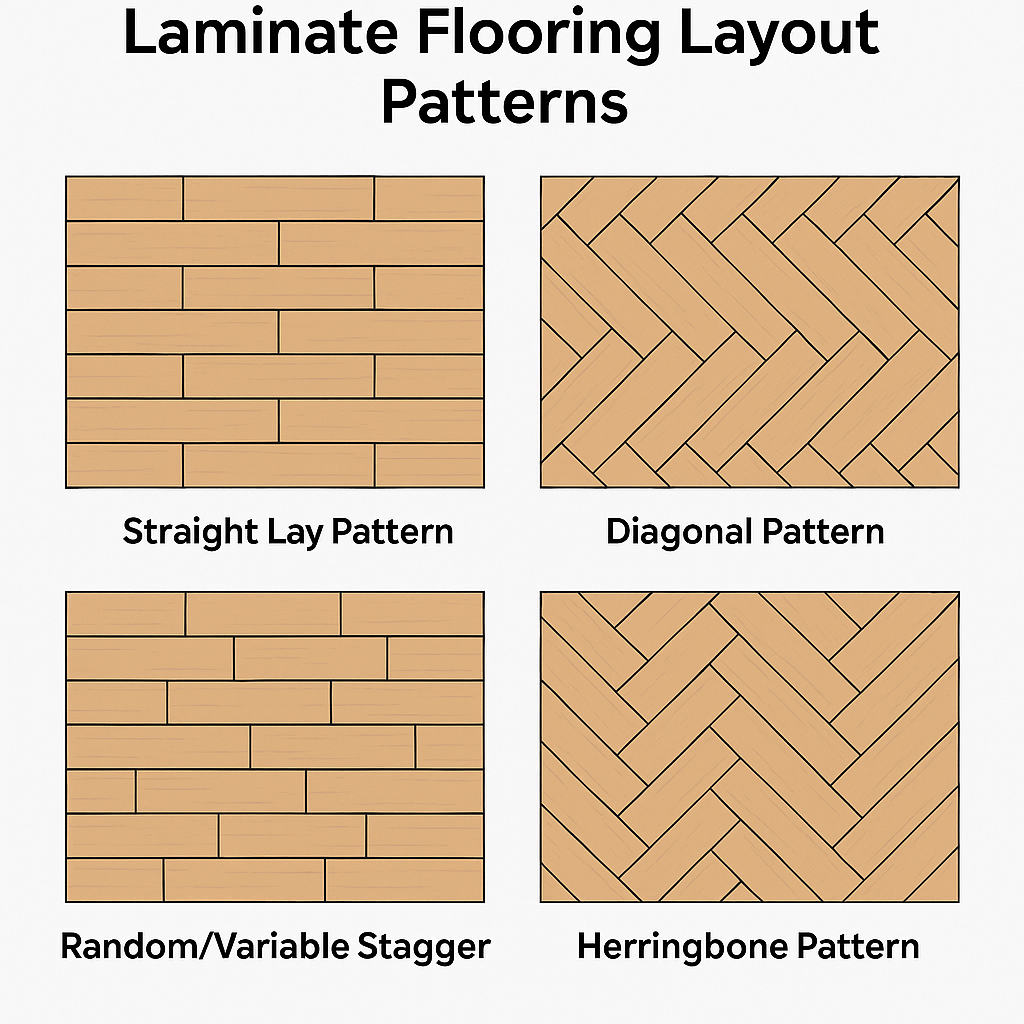
Step 2: Prepare the Space
Take Off Baseboards and Old Flooring
Begin by taking off any baseboards and your current flooring to make a clean surface.
Use a pry bar to gently remove the baseboards — do it slowly to avoid hurting the walls so you can use the trim again later.
If you’re changing carpet, cut it into smaller pieces with a utility knife and pull it up.
For vinyl or wood, follow the right way to take them out.
Clean and Check the Subfloor
Sweep and vacuum well to get rid of dust and dirt.
Look for cracks, dips, or bumps. Use a leveling compound to fill low spots and sand down raised areas. A smooth subfloor is key for a long-lasting laminate floor.
Put Down Underlayment
Most laminate floors need underlayment unless it’s already attached.
Underlayment gives cushioning, cuts down noise, and fixes small subfloor flaws.
Roll it out over the subfloor, ensuring edges meet without overlapping. Secure the seams with tape.
✅ Pro Tip: If installing on concrete, think about adding a moisture barrier under the underlayment.
Step 3: Choose an Installation Method
Laminate flooring is easy for DIY projects and mainly uses one simple installation method: Click-Lock (Floating Floor). Laminate usually doesn’t need glue or peel-and-stick methods.
Click-Lock (Floating Installation)
The Click-Lock system, also known as tongue-and-groove or interlocking, is the most common and DIY-friendly choice for laminate flooring. Plank edges click together, creating a strong bond without nails or glue.
This method lets the floor “float” over the subfloor, allowing it to expand and contract naturally with temperature and humidity changes.
Key Advantages:
No adhesives required — easier cleanup and fewer materials.
DIY-friendly — great for beginners.
Versatile — works well over different types of subfloors, including concrete and plywood.
Installation Tips:
Always leave a 1/4-inch expansion gap around the room using spacers. This stops buckling as the flooring expands and contracts.
Follow the manufacturer’s advice for plank alignment and clicking techniques.
Use a tapping block and pull bar to ensure tight seams without harming the plank edges.
Step 4: Lay the First Row
Trim the Short Tongue Edge of the First Plank
Start by cutting off the short tongue edge of your first plank. This helps it fit well against the wall for a neat look. Use a utility knife for thin laminates or a circular saw or miter saw for thick planks.
Position the First Plank 1/4 Inch from the Wall
Place the first plank by the wall, leaving a 1/4-inch gap. This space is needed because laminate floors move with temperature and humidity changes.
Insert Spacers to Maintain the Expansion Gap
Put spacers between the wall and floor to keep the gap even while laying the floor. Keep using these spacers all around the room’s edge.
Stagger End Joints for Stability and Appearance
For the second row, cut the first plank at least 6 inches shorter than the first plank of the row before. This staggers the end joints, making the floor stronger and look more natural.
Tip: Don’t line up joints across rows because it can make the floor weaker and look fake.
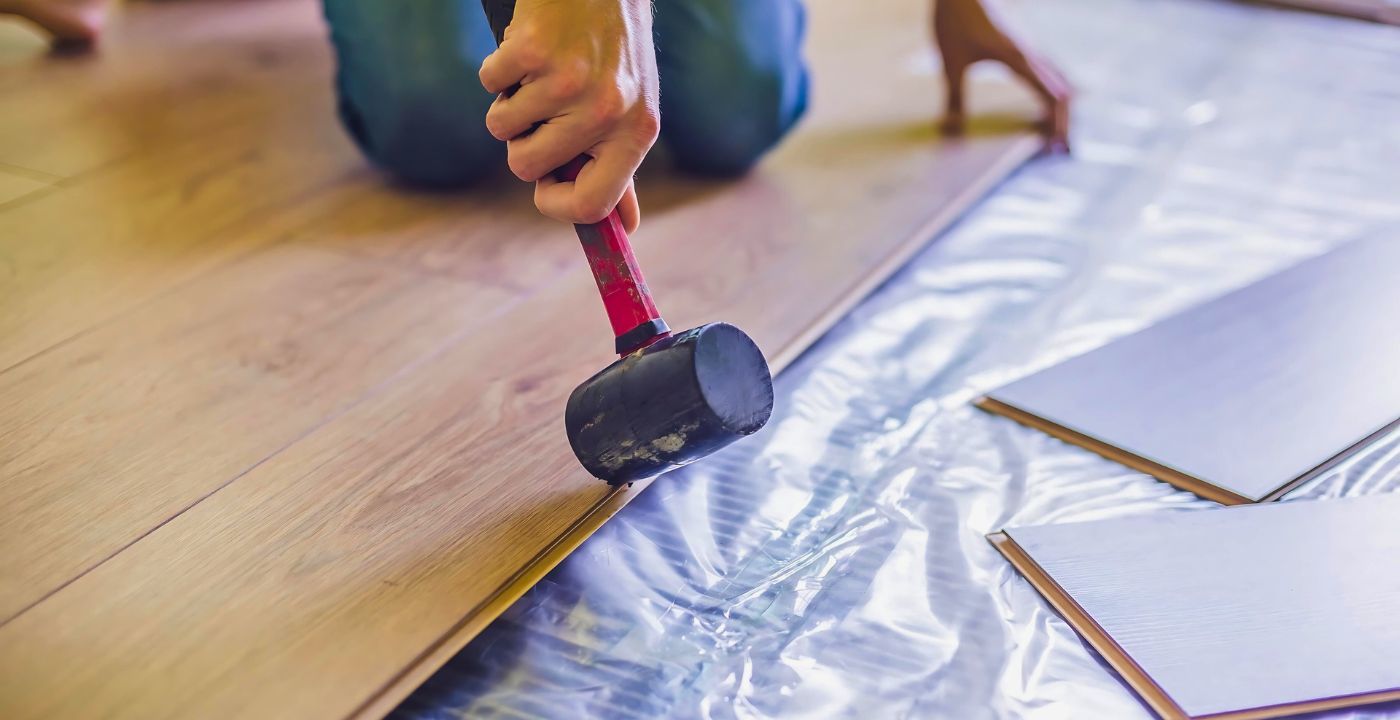
Step 5: Cutting Planks to Fit
Straight Cuts — Score and Snap
For straight cuts (like trimming the end of a plank):
Use a utility knife to mark your cutting line.
Snap the plank on the line for a clean break (works well for thin laminates).
For thicker laminate, use a laminate cutter, circular saw, or miter saw for clean cuts.
Irregular Cuts — Around Corners and Obstacles
When cutting around door frames or corners:
Use a jigsaw or oscillating multi-tool.
These tools make precise, curved, or angled cuts.
Cutting Around Pipes
Measure the diameter of the pipe and add 1 inch for expansion.
Drill a hole in the plank to fit the pipe.
Make a straight cut from the hole to the edge.
Seal around the pipe with a bead of silicone caulk to cover gaps.
Tight Spaces — Under Door Jambs
Use a jamb saw to trim the door frame bottom.
This lets you slide the plank under neatly.
Pro Tip: Wear safety goggles and work slowly to avoid damage.
| Cutting Task | Recommended Tool(s) | Technique |
|---|---|---|
| Straight cuts (length/width) | Utility knife (thin laminate) Laminate cutter or miter saw (standard) | Score and snap for thin laminate Use a saw for straight cuts |
| Irregular cuts (corners, curves) | Jigsaw or oscillating multi-tool | Mark the shape, cut slowly |
| Around pipes | Drill + Jigsaw or Hole saw | Drill a hole + cut to edge, leave gap |
| Tight spaces (door jambs) | Jamb saw (undercut saw) | Undercut the jamb to slide plank |
| Final fitting/trimming | Utility knife or laminate cutter | Trim excess for snug fit |
Step 6: Laying Subsequent Rows
Angle the Planks into Place
Start a new row by tilting the tongue of the plank into the groove of the row before it. Lower the plank gently until it clicks in place.
Use a Tapping Block and Non-Marring Hammer
To fit the planks tightly, use a tapping block and a hammer that won’t mar the surface.
Put the tapping block on the edge of the plank.
Tap softly to close any spaces between the planks.
Never use a regular hammer directly on the laminate—it could chip or harm the edges.
Maintain the Staggered Pattern
Keep staggering the ends by at least 6 inches for stability and a natural look.
Check Expansion Gaps
Use spacers by the walls to keep a 1/4-inch expansion gap during the installation.
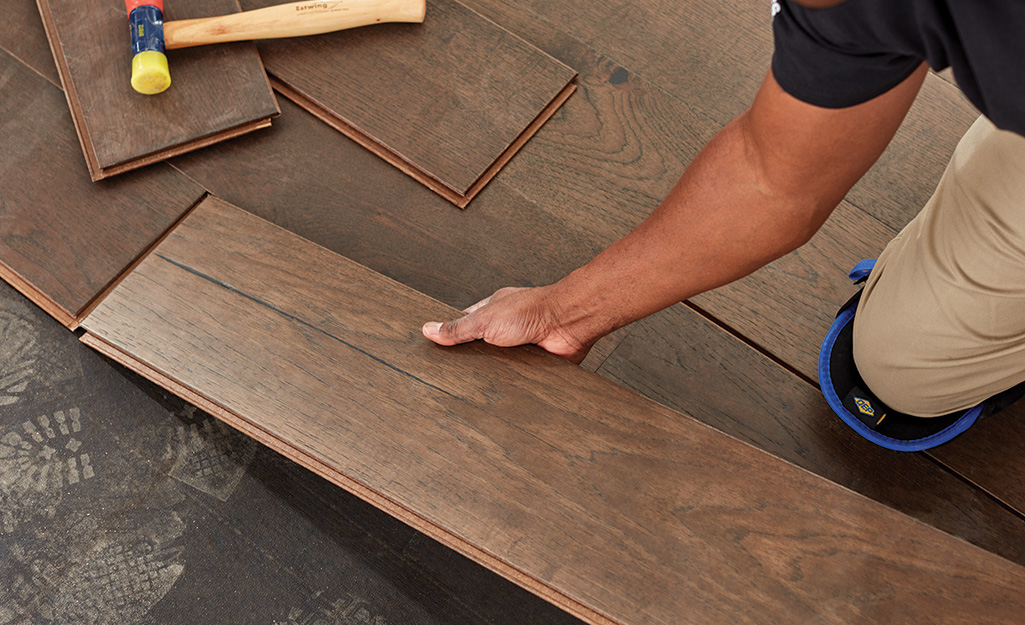
Step 7: Finishing the Installation
Install Transition Strips
After putting all planks in place, add transition strips at doorways and where laminate meets other floors. These strips:
Make a smooth, safe change.
Protect the edges of laminate floors.
Follow manufacturer’s instructions for type and fitting.
Transitioning to Other Flooring
Choose the right transition strip:
T-molding for floors of the same height.
Reducer strips for moving to lower surfaces like vinyl.
Attach transition strips to the subfloor, not directly to the laminate, leaving a 1/4-inch expansion gap to stop buckling.
Reinstall Baseboards
Put back baseboards, attaching them to the wall, not the floor. This lets the laminate expand and shrink freely underneath.
Allow the Floor to Settle
Before moving furniture back or walking a lot on the floor:
Wait at least 48 hours for the laminate to get used to the room’s temperature and humidity.
Common Mistakes to Avoid When Installing Laminate Flooring
High-Moisture Areas
Laminate floors aren’t good for very wet places like full bathrooms or laundry rooms. Water can get in the seams, causing them to swell or warp.
Using a Hammer on Planks
Don’t hit laminate with a hammer directly. Use a tapping block or pull bar to gently secure planks without damaging edges.
End Joints
Avoid aligning or overlapping end joints of planks in nearby rows. This can make the floor weak and cause gaps or uneven surfaces. Stagger the joints by at least 6 inches.
Expansion Gap
Not leaving a 1/4-inch expansion gap around the room’s edges can cause buckling as the floor changes with temperature and humidity.
Walking on New Floor
Let the laminate floor settle for 48 hours after it’s installed before walking on it or putting heavy furniture.
Tips for a Successful Laminate Flooring Installation
- Measure Carefully and Plan for Extras
Measure your room well and buy 10% more laminate flooring for cuts, errors, and future fixes. Check Planks Before You Start
Look at each plank for problems before installing. Remove any damaged ones to keep the finish nice.Wear Knee Pads for Comfort
Use knee pads to protect your knees during long work. They help you work better too.Work Slowly and Carefully
Go slow with each step, from the first row to cutting planks. Rushing can cause bad fits and mistakes.Keep the Right Expansion Gap
Leave a 1/4-inch gap around the edges so the laminate can move without buckling.
DIY vs. Professional Laminate Flooring Installation
Many people like laminate flooring because it’s easy to install yourself. Whether you install it or hire someone depends on how comfortable you are with the task, the tools you have, and how complicated the project is.
DIY Installation
✅ Pros:
You save money on labor costs.
You can work at your own speed.
Great for small, simple rooms.
❌ Cons:
You need basic tools like saws.
Mistakes can cause problems like warping.
It can take a lot of time, especially for big spaces.
Professional Installation
✅ Pros:
Quick and accurate installation.
Experts handle everything well.
Often comes with a warranty.
❌ Cons:
It costs more for labor.
On average, laminate flooring installation (materials + labor) costs between $4 and $12 per square foot depending on style and difficulty. For more details, see our Laminate Flooring Cost Guide.
| Installation Method | Average Cost per Sq Ft | Pros | Cons |
|---|---|---|---|
| DIY Installation | $1.50 – $4 (materials only) | Save on labor Flexible schedule Good for small areas | Time-consuming Requires tools & skills Mistakes can be costly |
| Professional Installation | $4 – $12 (materials + labor) | Fast & precise Warranty often included Handles complex cuts & transitions | Higher upfront cost |
Do You Need Professional Help With Your Laminate Flooring Installation Project?
If you want to learn how to install laminate flooring, you’re on your way to making a nice, strong floor. But if you prefer not to do it yourself, our skilled team can help.
We take care of every step — from getting the subfloor ready to aligning the planks perfectly — so you can relax and enjoy perfect, durable results. We’ll help you pick the best laminate style and underlayment for your home and budget.
Get in touch with us today to book your free home visit and check if we are in your area.


